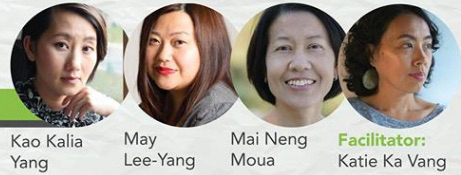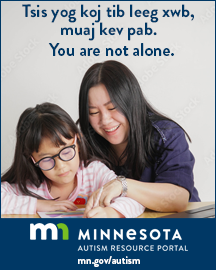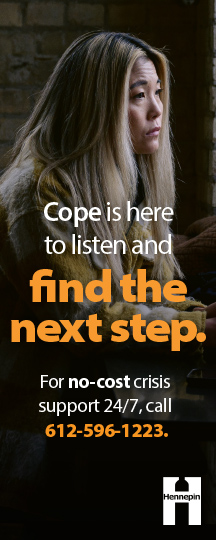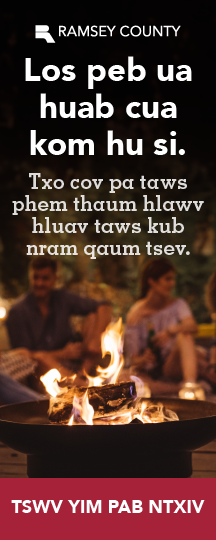Hmong Women Writers Panel At Maplewood Library
By Amy Doeun
Pa Na Lor, Communications Specialist for Ramsey County Library pulled together a panel of Hmong women writers at the Maplewood library. The room was packed with standing room only. She said she was inspired to host the panel because, “There is a kind of urgency in the Hmong community to keep storytelling as our elders get older because we are losing them and the oral history with it. We hope that this will be space for them to come together and magnify their stories and voices.”
The writers included May Lee-Yang, Kao Kalia Yang and Mai Neng Moua. Lor said that, “Storytelling was a broad topic in order to bring panelists across genres together. We didn’t want to exclude anyone because the writing circle in the Hmong community is rather small. All three women were accomplished writers and we wanted to create a space for all three of them to be in conversation together as they are already having similar conversations separately across the Twin Cities metro and out of state.”
Mai Neng Moua edited the first anthology of Hmong writing, Bamboo Among the Oaks, over a decade ago. She recently published a memoir, The Bride Price. She said of the panel. “I was excited to join this panel with Kao Kalia and May because they are two very accomplished women and I have tremendous respect for them and their work. It was the first time all three of us were on a panel together so it was very exciting.” She added that these types of events, “Makes my work accessible to community members. People know where the library is, the event is free.”
Kao Kalia Yang has written two family memoirs, The Latehomecomer and The Song Poet. She said, “I said yes to this invitation because it was high time that there was a public gathering of Hmong writers to talk about our experiences working in our respective fields, reflect on our journeys, and share a conversation before our community on the things that matter to us. As three of the pioneering voices in Hmong literature in America, I was interested in the kind of message we could deliver together.”
Being on the panel also added to her experience, “For me, the panel was a gift of perspective, and really a place in the shade across a landscape of bright sun. It is lonely to be a Hmong writer in the world we live in. It was nice to be among peers who are doing exciting, phenomenally different work from their place in the Hmong diaspora. I wanted to give our audience an exciting, historical event: three Hmong women writing at the same time, from much the same place, and building into the world a host of possibilities for a people in literature. Of course, it would have been wonderful to have: Soul Vang, Mai Der Vang, Khaty Xiong, and others present as well, but it was wonderful that there were three.”
May Lee-Yang works directly with Hmong elders. She is an educator, playwright and spoken word artist. “When Pa Na Lor who works at Ramsey County Library asked me to join this panel, I was excited about the opportunity to sit in conversation with Mai Neng and Kalia who are literary powerhouses. Based on the audience reaction—for Tuesday evening, the room was packed with folks standing in the back–it seemed like other people were also interested in what we might say about our artmaking process and identities as Hmong women.”
While all the women have had successful literary careers, they have all approached it from different directions, through different genres. “One attendee told me that what she enjoyed about the panel was how different all of us were. I think seeing those moments of connections and divergence in our work is eye opening as an artist. This community was also helpful in building connections to other folks who are interested in using the arts to talk about similar issues. For example, I was surprised at the number of people who were interested in partnering up on a project I’m currently working on called The Dead Hmong Women Project.” More on this to come
The crowded room was only one sign of impact the literature and the arts has on a community. As new generations come up the recorded histories of these women will never die.










